2005 年 11 月翻译资格考试二级英语笔译实务真题
Section 1: English-Chinese Translation(英译汉)
Part A Compulsory Translation(必译题)
Hans Christian Andersen was Denmark's most famous native son. Yet even after his
fairy tales won him fame and fortune, he feared he would be forgotten. He need not
have worried. This weekend, Denmark began eight months of celebrations to coincide
with the bicentenary of his birth, and Denmark is eager that the world take note
as it sets out to define the pigeon-holed writer in its own way.
The festivities began in Copenhagen on Saturday, Andersen's actual birthday, with
a lively show of music, dance, lights and comedy inspired by his fairy tales before
a crowd of 40,000people -- including Queen Margre the II and her family -- at the
Parken National Stadium. The opening, called Once Upon a Time, will be followed by
a slew of concerts, musicals, ballets, exhibitions, parades and education programs
costing over US$40 million.
So more than in recent memory, Danes -- and, they hope, foreigners -- will be reliving
the humor, pain and lessons to be found in evergreen stories like The Little Mermaid,
The Emperor's New Clothes, The Ugly Duckling, The Little Match-Seller, The Steadfast
Tin Soldier, The Shadow, The Princess and the Pea and others of Andersen's 150 or
so fairy tales.
In organizing this extravaganza, of course, Denmark is also celebrating itself.
After all, Andersen is still this country's most famous native son. Trumpeting his
name and achievements not only draws attention to Denmark's contribution to world
culture, but could also woo more foreign tourists to visit his birthplace in the
town of Odense and to be photographed beside the famous bronze statue of the Little
Mermaid in Copenhagen's harbor.
And Denmark has even more in mind. Local guardians of the Andersen legacy evidently
feel his stories have lost ground in recent years to the likes of J.R.R. Tolkien's
Lord of the Rings and J.K. Rowling’s Harry Potter. Andersen's fairy tales may remain
central to the Danish identity, serving as homespun guides to the vagaries of human
behavior, but what about the rest of the world?
"What we really need is a rebirth of Andersen," noted Lars Seeberg, secretary general
of the Hans Christian Andersen 2005 Foundation. "Two centuries after his birth, he
still fails to be universally acknowledged as the world-class author he no doubt
was.
�
Part B Optional Translation(二选一题)
Topic 1(选题一)
Independent Information and Analysis from the USA
The Gap between Rich and Poor Widened in U.S. Capital Washington D.C. ranks first
among the40 cities with the widest gap between the poor and the rich, according to
a recent report released by the D.C. Fiscal Policy Institute on July 22nd. The top
20 percent of household in D.C. have an average yearly income of $186,830, 31 times
that of the bottom 20 percent, which earns only $6,126 per year. The income gap is
also big in Atlanta and Miami, but the difference is not as pronounced.
The report also indicates that the widening gap occurred mainly during the 1990s.
Over the last decade, the average income of the top 20 percent of households has
grown 36 percent, while the average income of the bottom 20 percent has only risen
3 percent.
"I believe the concentration of the middle- to high-income families in the D.C. area
will continue, therefore, the income gap between rich and poor will be hard to
bridge," David Garrison told the Washington Observer. Garrison is a senior
researcher with the Brookings Institution, specializing in the study of the social
and economic policies in the greater Washington D.C. area.
The report attributed the persistent income gap in Washington to the area's special
job opportunities, which attract high-income households. Especially since the
federal government is based in Washington D.C., Government agencies and other
government related businesses such as lobbying firms and government contractors
constantly offer high-paying jobs, which contribute to the trend of increasing
high-income households in the D.C. area. For example, a single young professional
working in a law firm in D.C. can earn as much as $100,000 in his or her first year
out of law school.
"In addition, high-quality housing available in Washington D.C. is one of the main
reason swhy high-income families choose to live here, while middle and low-income
families, if they can afford it, choose to move out of Washington D.C. to the Virginia
and Maryland suburbs so that their kids can go to better schools," stated Garrison.
"As rich families continue to move into D.C. and middle and low-income families are
moving out, the poorest families are left with nowhere to move, or cannot afford
to move. This creates the situation we face now: a huge income gap between the rich
and poor."
The Washington D.C. area to which Garrison refers is the District of Columbia city
�
itself, not including the greater Washington metro area. "The greater Washington
metro area has a large population of about 5 million, but the low-income households
are often concentrated in D.C. proper," Garrison explained.
Tony Blalock, the spokesperson for Mayor Anthony Williams, said resignedly, "No
matter what we seem to do to bring investment into the District, a certain population
is not able to access the unique employment opportunities there. The gap between
the rich and poor is the product of complex forces, and won't be fixed overnight."
Garrison believes that the D.C. government should attract high-income families. By
doing so, the District's tax base can grow, which in turn can help improve
D.C.'s infrastructure. "But in the meantime, the District government should also
take into consideration the rights of the poor, set up good schools for them, and
provide sound social welfare. All these measures can alleviate the dire situation
caused by income disparity. "
Garrison, however, is not optimistic about the possibility of closing the gap between
the rich and poor. He is particularly doubtful that current economic progress will
be able to help out the poor. "Bush's tax-cut plan did bring about this wave of
economic recovery, and the working professionals and rich did benefit from it. It
is unfair to say that the plan did not help the poor at all… it just didn't benefit
them as much as it did the rich, " Garrison said. "The working class in America,
those who do the simplest work, get paid the least, and dutifully pay their taxes,
has not benefited from Bush's tax-cut plan much."
Garrison concludes, "A lot of cities in America did not enjoy the positive impact
of the economic recovery. Washington D.C., on the other hand, has always been
sheltered by the federal government. The wide gap between rich and poor in the
District, therefore, deserves more in-depth study and exploration."
Topic 2(选题二)
Sometimes you can know too much. The aim of screening healthy people for cancer is
to discover tum ours when they are small and treatable. It sounds laudable and often
it is. But it sometimes leads to unnecessary treatment. The body has a battery of
mechanisms for stopping small tum ours from becoming large ones. Treating those that
would have been suppressed anyway does no good and can often be harmful.
Take lung cancer. A report in this week's Journal of the American Medical Association,
by Peter Bach of the Memorial Sloan-Kettering Cancer Centre in
New York and his colleagues, suggests that, despite much fanfare around the use of
computed tomography (CT) to detect tum ours in the lungs well before they cause
�
symptoms, the test may not reduce the risk of dying from the disease at all—indeed,
it may make things worse.
The story begins last year, when Claudia Henschke of Cornell University and her
colleagues made headlines with a report that patients whose lung cancer had been
diagnosed early by CT screening had excellent long-term survival prospects. Her
research suggested that 88% of patients could expect to be alive ten years after
their diagnosis. Dr Bach found similar results ina separate study. In his case, 94%
of patients diagnosed with early-stage lung cancer were alive four years later.
Survival data alone, though, fail to answer a basic question: “compared with what?”
People are bound to live longer after their diagnosis if that diagnosis is made
earlier. Early diagnosis is of little value unless it results in a better prognosis.
Dr Bach, therefore, interrogated his data more thoroughly. He used statistical
models based on results from studies of lung cancer that did not involve CT screening,
to try to predict what would have happened to the individuals in his own study if
they had not been part of that study. The results were not encouraging.
Screening did, indeed, detect more tum ours. Over the course of five years, 144 cases
of lung cancer were picked up in a population of 3,200, compared with a predicted
number of 44.Despite these early diagnoses, though, there was no reduction in the
number of people who went on to develop advanced cancer, nor a significant drop in
the number who died of the disease (38, compared with a prediction of 39). Considering
that early diagnosis prompted at enfold increase in surgery aimed at removing the
cancer (the predicted number of surgical interventions was 11; the actual number
was 109), and that such surgery is unsafe—5% of patients die and another 20-40%
suffer serious complications—the whole process seems to make things worse.
Section 2: Chinese-English Translation(汉译英)
Part A
25 年来,中国坚定不移地推进改革开放,社会主义市场经济体制初步建立,开放型经济已
经形成,社会生产力和综合国力不断增强,各项社会事业全面发展,人民生活总体上实现了
由温饱到小康的历史性跨越。从 1978 年至 2003 年的 25 年间,中国经济年均增长 9.4%。25
年前,中国年国内生产总值为 1473 亿美元,去年已达到 14000 多亿美元。25 年前,
中国年进出口贸易总额为 206 亿美元,去年已达到 8512 亿美元。25 年前,中国外汇储备为
1.67 亿美元,去年已达到 4033 亿美元。目前,中国经济总量居世界第六,进出口贸易总额
居世界第四。中国之所以能够发生这样巨大的变化,最关键的原因是我们始终坚持走中国特
色社会主义道路,始终坚持改革开放,激发了全体人民的积极性、主动性、创造性。 中国
虽然取得了很大的发展成就,但中国人口多,底子薄,生产力不发达,发展很不平衡,生态
环境、自然资源与经济社会发展的矛盾比较突出。虽然中国人均国内生产总值已经突破 1000
�
美元,但仍排在世界一百位以后。中国要实现现代化,使全体人民都过上富裕生活,还需要
进行长期不懈的艰苦奋斗。
我们已经明确了本世纪头 20 年的奋斗目标,这就是全面建设惠及十几亿人口的更高水平的
小康社会,到 2020 年实现国内生产总值比 2000 年翻两番,达到 4 万亿美元,人均国内生产
总值达到 3000 美元,使经济更加发展、民主更加健全、科教更加进步、文化更加繁荣、社
会更加和谐、人民生活更加殷实。
Part B
科技进步与技术创新
20 世纪,人类取得了巨大的成就,其中尤其以科学技术的进步为最大。可以预料,在 20 世
纪,科学技术的迅速发展和高科技产业的兴起。将推动世界经济继续有农业经济进而向知识
经济嬗变。世界正在发生深刻的变化:经济与科学技术的结合与日俱增;世界经济的重组加
快步伐;经济繁荣不仅取决于资源和资本的总量,而且直接有赖于技术知识和信息的积累和
运用。创新是新时代的主题,对于世界的社会经济发展至关重要。
为了实现现在化目标,中国下绝对对科技和教育进行投资。中国政府决定加大技术创新的力
度,发展高科技,完成工业化。这对新世纪的中国有着重要意义,是振兴中华民族的必由之
路。为此,中国将鼓励创新,加快商业化、工业化和国家化的进程。
中国将实施全国科技发展的长期规划,以此重新适应世界的工业结构和国际市场的变化。同
时,中国还将实施可持续发展的战略,促进全国的创新工作,加快技术进步,努力解决国民
经济中的主要问题,加快我国科技事业的发展。
�
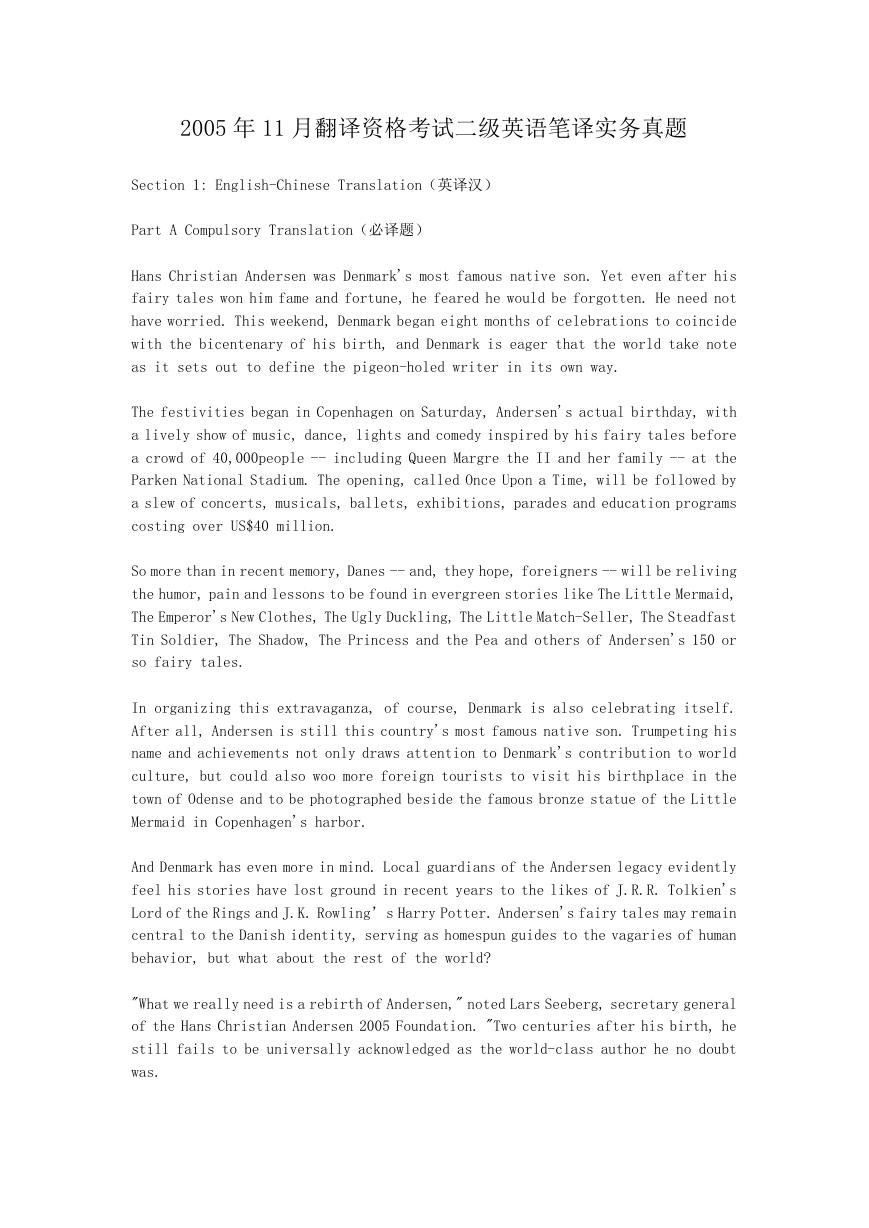
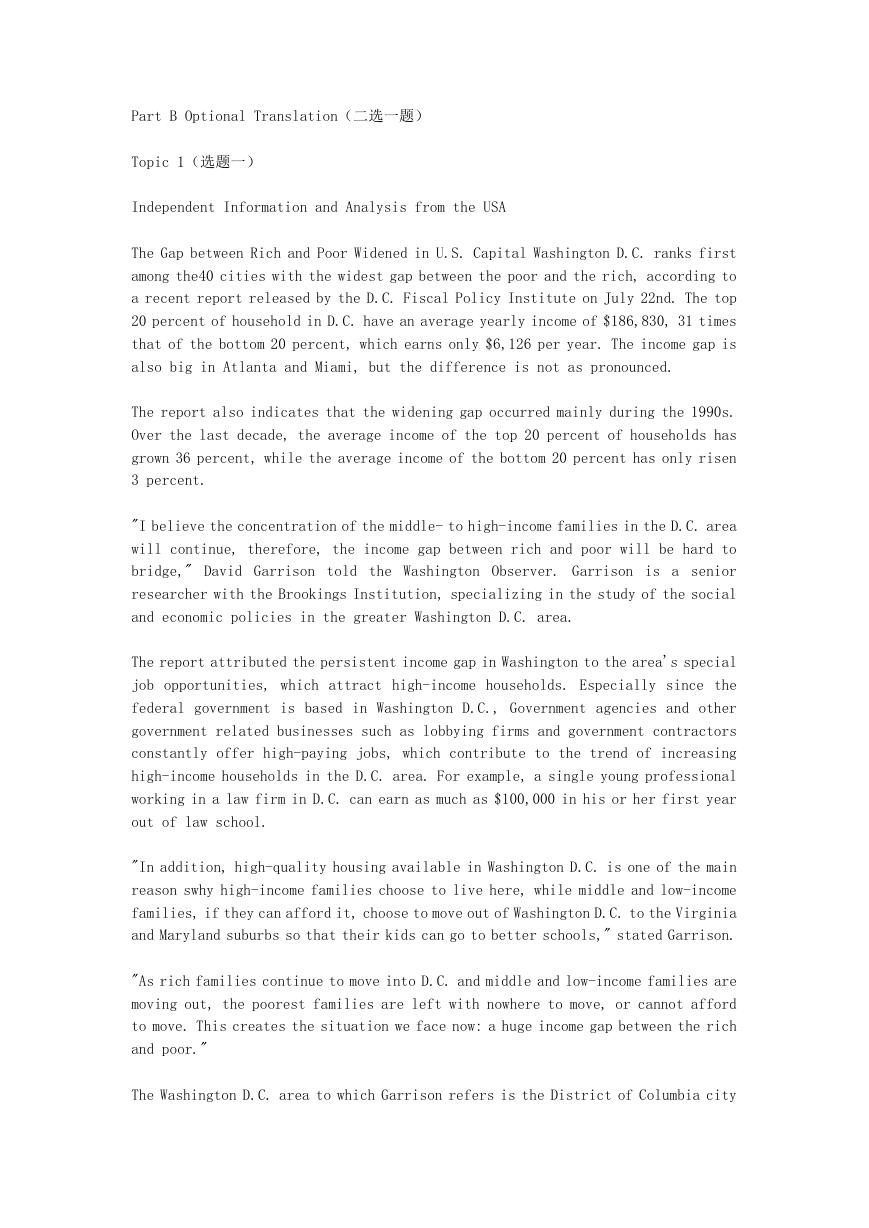
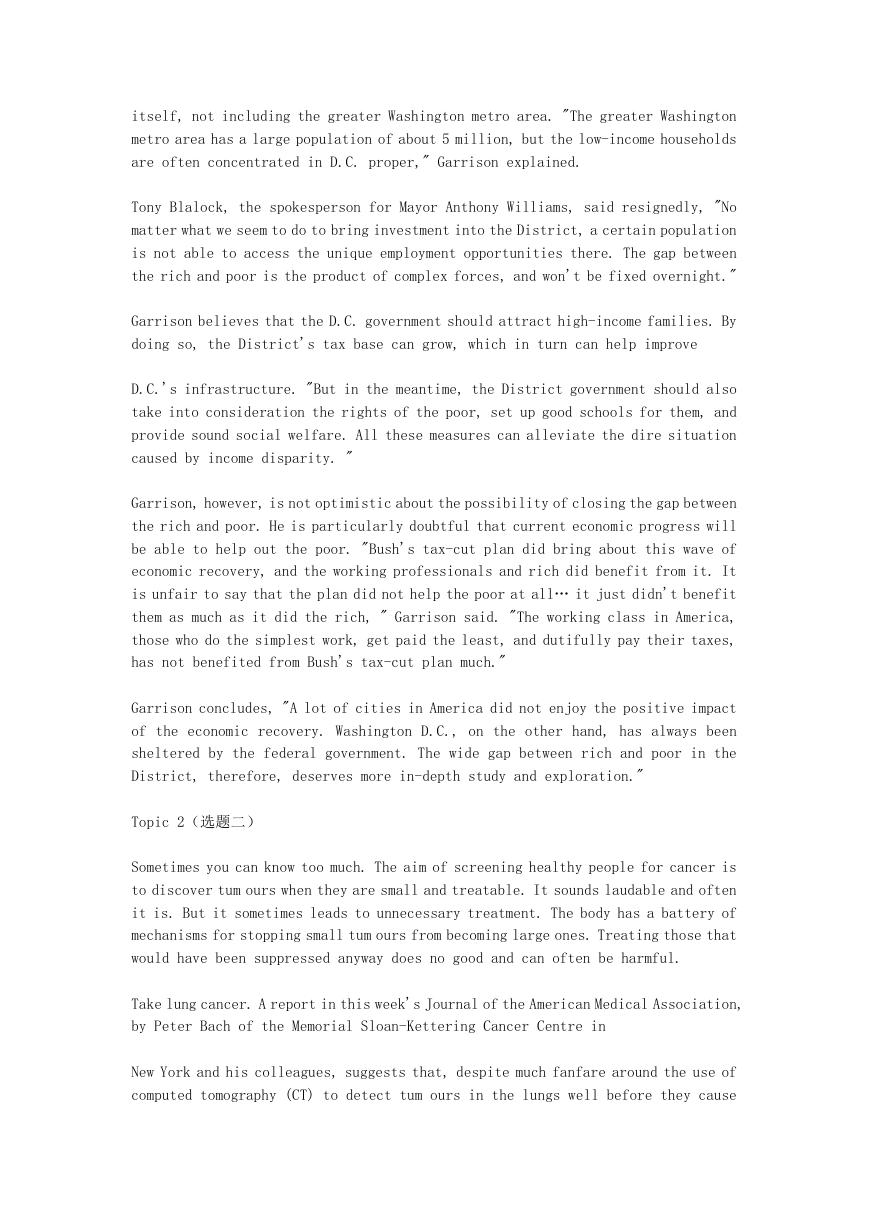
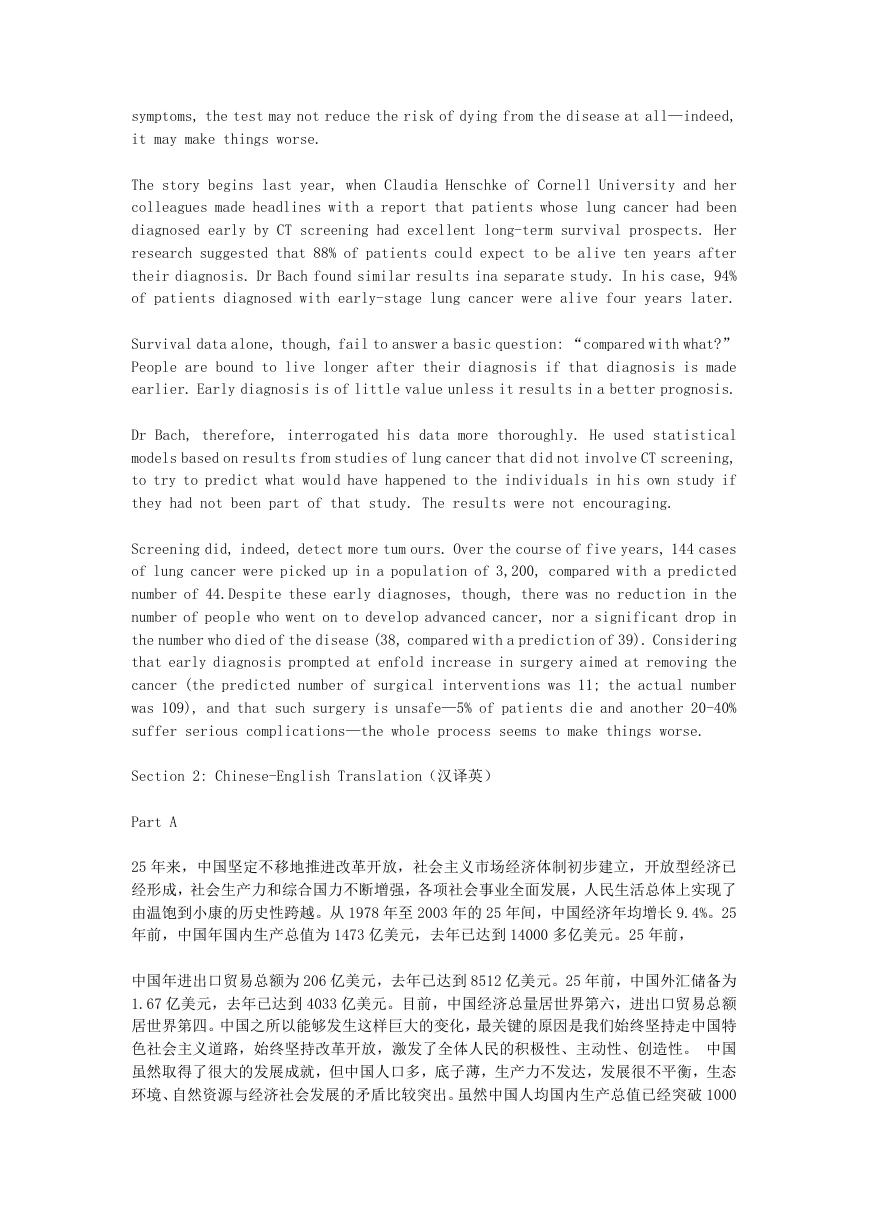
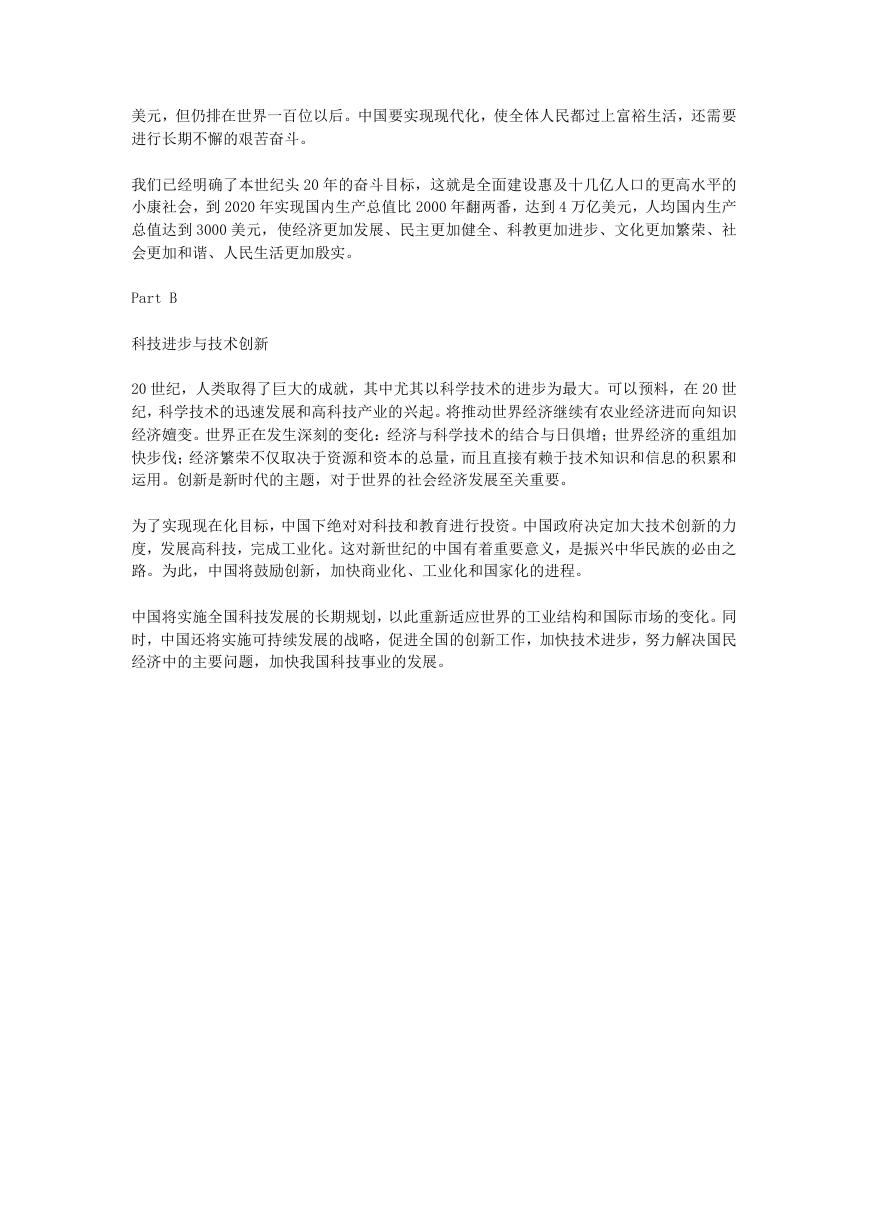





 2023年江西萍乡中考道德与法治真题及答案.doc
2023年江西萍乡中考道德与法治真题及答案.doc 2012年重庆南川中考生物真题及答案.doc
2012年重庆南川中考生物真题及答案.doc 2013年江西师范大学地理学综合及文艺理论基础考研真题.doc
2013年江西师范大学地理学综合及文艺理论基础考研真题.doc 2020年四川甘孜小升初语文真题及答案I卷.doc
2020年四川甘孜小升初语文真题及答案I卷.doc 2020年注册岩土工程师专业基础考试真题及答案.doc
2020年注册岩土工程师专业基础考试真题及答案.doc 2023-2024学年福建省厦门市九年级上学期数学月考试题及答案.doc
2023-2024学年福建省厦门市九年级上学期数学月考试题及答案.doc 2021-2022学年辽宁省沈阳市大东区九年级上学期语文期末试题及答案.doc
2021-2022学年辽宁省沈阳市大东区九年级上学期语文期末试题及答案.doc 2022-2023学年北京东城区初三第一学期物理期末试卷及答案.doc
2022-2023学年北京东城区初三第一学期物理期末试卷及答案.doc 2018上半年江西教师资格初中地理学科知识与教学能力真题及答案.doc
2018上半年江西教师资格初中地理学科知识与教学能力真题及答案.doc 2012年河北国家公务员申论考试真题及答案-省级.doc
2012年河北国家公务员申论考试真题及答案-省级.doc 2020-2021学年江苏省扬州市江都区邵樊片九年级上学期数学第一次质量检测试题及答案.doc
2020-2021学年江苏省扬州市江都区邵樊片九年级上学期数学第一次质量检测试题及答案.doc 2022下半年黑龙江教师资格证中学综合素质真题及答案.doc
2022下半年黑龙江教师资格证中学综合素质真题及答案.doc